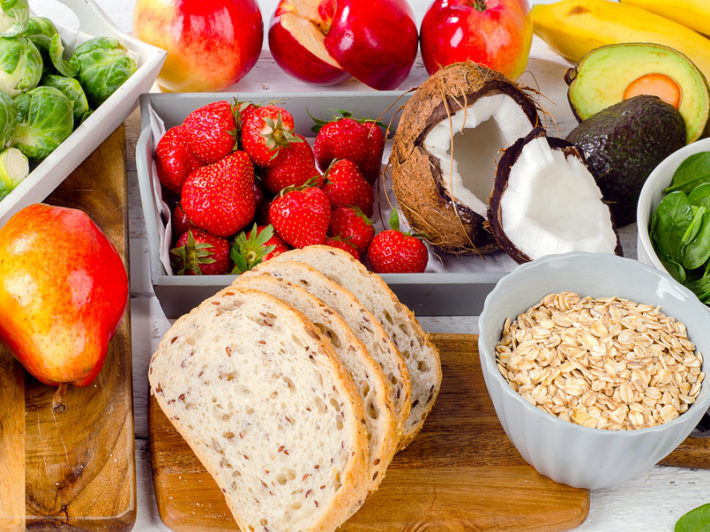Prebiotics are substances that provide nutrients to healthy bacteria in the intestines, which are important for certain aspects of your health, such as digestion and immune function. The best way to increase your intake of prebiotics is to eat fibre-rich plant foods such as beans, certain fruits, whole grains, and seeds. Some common examples of prebiotics are inulin and oligofructose, which can be found in foods such as leeks and bananas.
The best way to make sure you are consuming enough prebiotics is to eat a variety of foods, especially fruits and vegetables. Focusing on a diet plan with lots of whole foods, such as fresh fruits, vegetables, and whole grains, is the greatest technique for increasing your natural prebiotic consumption. If you eat a variety of nutrient-rich whole foods or eat a diet rich in vegetables, you are probably already getting a lot of prebiotic foods.
It’s worth noting that many of these foods are also high in dietary fibre (coarse grains) and resistant starch, in addition to natural prebiotics. Foods that contain a lot of insoluble fibre (not digested) are usually good sources of prebiotics.
Unlike probiotics, which quickly infect the gut with beneficial bacteria (sort of like a sugar rush), prebiotics act as long-term gut food. Fortunately, prebiotics, available in many different flavors, are found in many delicious foods. The good news is that these prebiotics are found in a variety of plant foods, so if you’re eating a mixture of fruits, vegetables, and whole grains, you probably don’t need prebiotic supplements. When looking for the best foods that are high in prebiotic fibre, it’s important to note that there are 8 categories of prebiotics that have proven health benefits.
Polyphenols, inulin, and resistant starches are some of the most common prebiotics. Prebiotics are fibre-based food ingredients that are difficult for the body to digest. On the other hand, prebiotics are a type of soluble fibrethat only the intestines can digest.
Fibre must travel undigested through the gastrointestinal tract and boost the growth and/or activity of some beneficial bacteria in the large intestine to be categorised as a prebiotic. Simply put, prebiotics are an essential food for microorganisms in the gut, also known as the microbiome.
Probiotics are beneficial living bacteria that help maintain gut health by supporting the immune system and aiding digestion. A healthy gut is full of good bacteria called probiotics and prebiotics. Prebiotics are dietary fibre (carbohydrates) that cannot be digested by humans but are the prefered source of fuel and nutrition for our good bacteria in the gut. They are made up of oligosaccharides, inulin, lactulose, and glycan. Prebiotics are substances found in food that are thought to feed our gut’s “healthy” bacteria.
Adding prebiotics to your daily diet can promote the development of beneficial bacteria in your intestines, strengthen your immune system, and support a healthy digestive system. Incorporating probiotics and prebiotics into your diet every day can create miracles for gut health, diet and a healthy lifestyle. Eating foods rich in prebiotics and probiotics has many proven and potential health benefits.
Prebiotics are abundant in a diet rich in whole foods and plenty of fruits and vegetables, which will aid your intestines and digestion in the long run. You need probiotic support to improve digestion and overall health. Prebiotic foods and extra support ensure that your gut bacteria get the nutrients they need to stay healthy.
You need prebiotic foods in your diet, because increasing the number of probiotic flora such as bifidobacteria can help reduce the number of potentially harmful bacteria in the colon by increasing the pH of the intestines (which is less beneficial for “bad” bacteria). Frequently, it will actually boost your immune function. Probiotic foods such as yogurt, apple cider vinegar, sauerkraut and other fermented foods all contain live beneficial bacteria. Their prebiotic properties are derived from natural fibre, which nourishes the beneficial bacteria in the human intestines and helps fight harmful bacteria.

In recent years, the definition of prebiotics has expanded from being viewed simply as bacteria feeding the fibres in the colon to any compound that can be used by microorganisms to improve health. While probiotics help replenish the gut bacteria that live inside you, prebiotics are needed to feed those same bacterial allies.
While you can always opt for high-quality supplements that contain beneficial prebiotics, you can also add a number of foods to your diet that give your gut bacteria all the fibre they need. And even if you haven’t taken probiotics yet, you should probably still include these foods in your diet; Research shows that simply adding prebiotic vegetables to an unhealthy diet can begin to alter our gut composition, strengthening our beneficial microbes. Below, we’ve compiled a list of the best prebiotics to boost gut repair and help you get leaner and happier.
Keep in mind that for the maximum benefit from the prebiotics found in any food, it is best consumed raw. When it comes to prebiotic foods, asparagus has roughly 5% fibre by weight, but it’s tough to digest uncooked, which is the ideal way to get prebiotics.
The simplest method to increase prebiotic foods in your diet is to replace refined grains with fibre-rich whole grains like wheat, rye, and barley. In addition to avoiding processed foods that create an unfavorable environment for the survival of microorganisms, including foods containing prebiotic matrix and prebiotic supplements (as needed), they can also boost the growth, health, and survival of beneficial gut flora. You can also consume probiotic foods such as kefir and kimchi or take supplements to help these bacteria grow and multiply.

